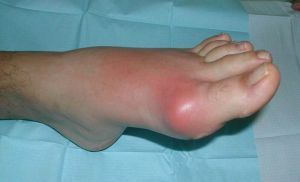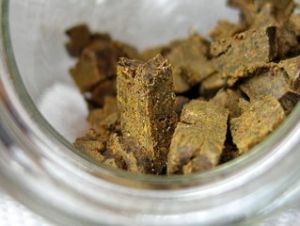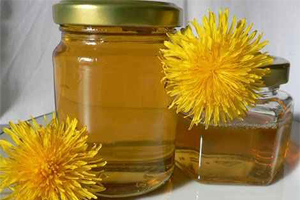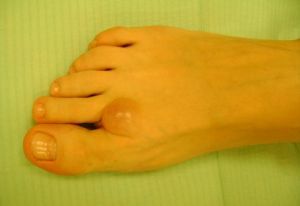 What is the hygroma of the foot and what is the essence of the disease?
What is the hygroma of the foot and what is the essence of the disease?
A pathology appears in the form of a benign tumor in the foot area and is characterized by fluid accumulation( mucus or fibrin impurities) that forms in the serous bag of the joint.
This type of pathology is rare.
Pathology more often is located on the back of the foot , where the synovial bag is located.
Doctors-trauma specialists distinguish the following reasons, as a result of which a hygroma can be formed:
- wearing poorly selected footwear;
- heavy physical stress on the feet;
- joint injury;
- hereditary factor;
- chronic diseases, which are inflammatory.
Contents of the article
- Symptoms and Diagnosis of the Disease
- How to get rid of the disease?
- Conservative therapy
- Surgical treatment
- Traditional therapies
- Preventative measures for the prevention of the disease
- Video: How does the hygroma of the foot on the MRI look like
Symptoms and diagnosis of the disease
Education localized in the foot slowly grows. For a long time of its existence it can grow up to 3 cm and without causing any inconvenience to its owner.
During growth of education, a person feels a slight dull pain in the foot, which occurs as a result of stretching the synovial bag. When playing sports or heavy loads on feet, the pain intensifies.
The main symptoms of hygroma of foot include the following symptoms:
- redness of the skin;
- drawing pain when moving or pressure in the foot area;
- rounded formation, accompanied by a slight soreness during growth;
- immobility and smoothness of the ganglion or vice versa thickening and roughness.
Symptoms can manifest themselves in different ways - it depends on the location of the tumor and the individual course of the pathological process. In some patients, the joints decrease their mobility. The disease can take a chronic form, which is characterized by bouts of severe pain over a long period.
Hygroma on stack detected by palpation ( palpation), and visual inspection physician. The diagnosis is based on anamnesis and clinical symptoms. Sometimes the following can be prescribed:
- radiography ( to avoid damage to the joint bones);
- US ( for determining the structure of education);
- MRI ( for the detection of nodes).
- puncture ( analysis of the contents of the hygroma capsule).
The method of differential diagnosis is selected by a specialist.
How to get rid of the disease?
Ways of treating hygroma mass, it all depends on the size of the pathology and the degree of neglect of the disease. If the process of tumor development is at an early stage 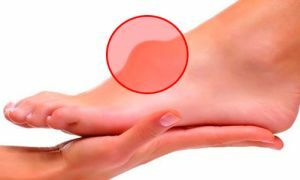 , deal with it, you can use conservative treatment and traditional medicine. In a neglected case, only surgical treatment can help. Conservative therapy
, deal with it, you can use conservative treatment and traditional medicine. In a neglected case, only surgical treatment can help. Conservative therapy
Treatment includes:
- applications with paraffin and sludge;
- heat treatment.
- physiotherapy - electrophoresis with iodine and ultrasound.
Quite efficient methods are also the following procedures:
- Crushing. The formation is crushed by pressing it with your fingers or a flat object. As a result, the ganglion bursts, and its contents are poured into tissues that are located near. After some time, the liquid dissolves;
- Puncture. Characterized by the withdrawal of syringe contents from the cavity of the hygroma, followed by its filling with glucocorticoid hormones or antibiotics.
After these procedures, the foot is fixed with a gypsum or orthopedic fixer for a week. This is necessary to reduce the process of reducing the fluid in the synovial bag.
Surgical treatment of
Indications for removal of foot hygroma by surgery are:
- severe pain in the foot;
- limitation of mobility;
- rapid growth;
- complications( redness, suppuration, swelling).
Removal procedures are performed by bursectomy or laser evaporation. The goal of both methods is one - to excise completely the capsule of the ganglion, including pathological tissue sites:
- Bursectomy. The surgeon removes with the scalpel a capsule of the foot hygroma along with its base, the wound is washed and then sutured. The operation lasts up to 20-30 minutes. In conclusion, the joint is fixed with a gypsum lint or a compression bandage. Recovery comes on 7-20 days after the operation.
- Laser removal. This method has several advantages. Under the influence of the laser, the hygroma collapses completely. The procedure is painless, does not cause blood loss, subsequent scarring and completely excludes the development of complications. After surgery, a fixative bandage is also shown.
Operative intervention, both in the first and second cases, is performed with the use of anesthesia.
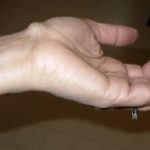 Than the wrist hygroma is unpleasant and the peculiarity of the pathology treatment is described in detail in our article. In the same place you will find recipes of traditional medicine.
Than the wrist hygroma is unpleasant and the peculiarity of the pathology treatment is described in detail in our article. In the same place you will find recipes of traditional medicine.
For information on why cervical myositis occurs and what you should know, before you start treating the disease, you can find it here.
Traditional methods of treatment
Treatment of foot hygroma with folk remedies is good used in conjunction with conservative treatment - this will help to get rid of the hygroma more quickly.
Let's consider some effective recipes proven by time:
- On clean cabbage leaf spread a thin layer of honey and attach to the area of the foot where the tumor settled, from the top, fix the bandage for 3 hours. After the expiration of the time, the compress should be replaced;
- 2 tbsp./ l. Sea salt dissolve in a glass of water and add red clay .Mix everything. The resulting composition should be applied with a thick layer on the area of the hygroma and fixed. To go with this compress it takes a whole day, as the clay dries out, moisten the bandage with water;
- Grind fresh wormwood , and attach to the lesion focus, secure.
If improvement is not seen, you should consult a specialist and discuss with him the issue of possible surgical treatment.
Preventative measures to prevent the disease
Prevention consists in choosing and wearing comfortable shoes, excluding strong overstrain of the feet, preventing their traumatization, and also in the timely treatment of accompanying pathologies.

